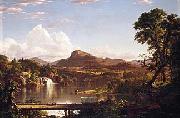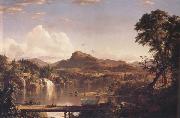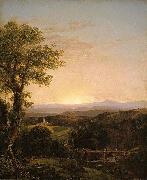Wholesale Oil Painting No Minimum |
|||||||||||
|
|
|||||||||||

|
|||||||||||
|
|
|
||||||||
Frederick Edwin Church1826-1900 Frederick Edwin Church Galleries Frederic Edwin Church (May 4, 1826 ?C April 7, 1900) was an American landscape painter born in Hartford, Connecticut. He was a central figure in the Hudson River School of American landscape painters. While committed to the natural sciences, he was "always concerned with including a spiritual dimension in his works". The family wealth came from Church's father, Joseph Church, a silversmith and watchmaker in Hartford, Connecticut.(Joseph subsequently also became an official and a director of The Aetna Life Insurance Company) Joseph, in turn, was the son of Samuel Church, who founded the first paper mill in Lee, Massachusetts in the Berkshires, and this allowed him(Frederic) to pursue his interest in art from a very early age. At eighteen years of age, Church became the pupil of Thomas Cole in Catskill, New York after Daniel Wadsworth, a family neighbor and founder of the Wadsworth Atheneum, introduced the two. In May 1848, Church was elected as the youngest Associate of the National Academy of Design and was promoted to Academician the following year. Soon after, he sold his first major work to Hartford's Wadsworth Atheneum. Church settled in New York where he taught his first pupil, William James Stillman. From the spring to autumn each year Church would travel, often by foot, sketching. He returned each winter to paint and to sell his work. Between 1853 and 1857, Church traveled in South America, financed by businessman Cyrus West Field, who wished to use Church's paintings to lure investors to his South American ventures. Church was inspired by the Prussian explorer Alexander von Humboldt's Cosmos and his exploration of the continent; Humboldt had challenged artists to portray the "physiognomy" of the Andes. |
||||||||
|
|
||||||||
New England Scenery
New England Scenery Painting ID:: 3880 |
1851
Springfield Library and Museums 1851 Springfield Library and Museums |
|||||||
|
|
||||||||
Frederic E.Church1826-1900 American painter. He was a leading representative of the second generation of the HUDSON RIVER SCHOOL, who made an important contribution to American landscape painting in the 1850s and 1860s. The son of a wealthy and prominent businessman, he studied briefly in Hartford with two local artists, Alexander Hamilton Emmons (1816-84) and Benjamin Hutchins Coe (1799-1883). Thanks to the influence of the Hartford patron DANIEL WADSWORTH, in 1844 he became the first pupil accepted by Thomas Cole. |
||||||||
|
|
||||||||
|
|
New England Scenery
New England Scenery Painting ID:: 26180 |
mk48
1851
Oil on canvas
36x33in
George Walter Vincent Smith Art Museum,Springfield,Massachusetts,George Walter Vincent mk48 1851 Oil on canvas 36x33in George Walter Vincent Smith Art Museum,Springfield,Massachusetts,George Walter Vincent |
||||||
|
|
||||||||
Thomas Cole1801-1848 Thomas Cole Galleries Thomas Cole (February 1, 1801 - February 11, 1848) was a 19th century American artist. He is regarded as the founder of the Hudson River School, an American art movement that flourished in the mid-19th century. Cole's Hudson River School, as well as his own work, was known for its realistic and detailed portrayal of American landscape and wilderness, which feature themes of romanticism and naturalism. In New York he sold three paintings to George W. Bruen, who financed a summer trip to the Hudson Valley where he visited the Catskill Mountain House and painted the ruins of Fort Putnam. Returning to New York he displayed three landscapes in the window of a bookstore; according to the New York Evening Post, this garnered Cole the attention of John Trumbull, Asher B. Durand, and William Dunlap. Among the paintings was a landscape called "View of Fort Ticonderoga from Gelyna". Trumbull was especially impressed with the work of the young artist and sought him out, bought one of his paintings, and put him into contact with a number of his wealthy friends including Robert Gilmor of Baltimore and Daniel Wadsworth of Hartford, who became important patrons of the artist. Cole was primarily a painter of landscapes, but he also painted allegorical works. The most famous of these are the five-part series, The Course of Empire, now in the collection of the New York Historical Society and the four-part The Voyage of Life. There are two versions of the latter, one at the National Gallery in Washington, D.C., the other at the Munson-Williams-Proctor Arts Institute in Utica, New York. Cole influenced his artistic peers, especially Asher B. Durand and Frederic Edwin Church, who studied with Cole from 1844 to 1846. Cole spent the years 1829 to 1832 and 1841-1842 abroad, mainly in England and Italy; in Florence he lived with the sculptor Horatio Greenough. |
||||||||
|
|
||||||||
|
|
New England Scenery
New England Scenery Painting ID:: 86021 |
Date 1839(1839)
Medium Oil on canvas
cjr Date 1839(1839) Medium Oil on canvas cjr |
||||||
|
|
||||||||
|
Thomas Cole 1801-1848 Thomas Cole Galleries Thomas Cole (February 1, 1801 - February 11, 1848) was a 19th century American artist. He is regarded as the founder of the Hudson River School, an American art movement that flourished in the mid-19th century. Cole's Hudson River School, as well as his own work, was known for its realistic and detailed portrayal of American landscape and wilderness, which feature themes of romanticism and naturalism. In New York he sold three paintings to George W. Bruen, who financed a summer trip to the Hudson Valley where he visited the Catskill Mountain House and painted the ruins of Fort Putnam. Returning to New York he displayed three landscapes in the window of a bookstore; according to the New York Evening Post, this garnered Cole the attention of John Trumbull, Asher B. Durand, and William Dunlap. Among the paintings was a landscape called "View of Fort Ticonderoga from Gelyna". Trumbull was especially impressed with the work of the young artist and sought him out, bought one of his paintings, and put him into contact with a number of his wealthy friends including Robert Gilmor of Baltimore and Daniel Wadsworth of Hartford, who became important patrons of the artist. Cole was primarily a painter of landscapes, but he also painted allegorical works. The most famous of these are the five-part series, The Course of Empire, now in the collection of the New York Historical Society and the four-part The Voyage of Life. There are two versions of the latter, one at the National Gallery in Washington, D.C., the other at the Munson-Williams-Proctor Arts Institute in Utica, New York. Cole influenced his artistic peers, especially Asher B. Durand and Frederic Edwin Church, who studied with Cole from 1844 to 1846. Cole spent the years 1829 to 1832 and 1841-1842 abroad, mainly in England and Italy; in Florence he lived with the sculptor Horatio Greenough. New England Scenery Date 1839(1839) Medium Oil on canvas cjr |
||||||||
|
|
||||||||
|
Prev Next
|
||||||||
|
|
||||||||
|
Related Paintings to Thomas Cole :. |
||||||||
|
|
||||||||
|
CONTACT US |



